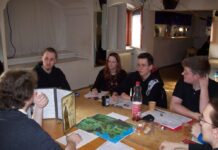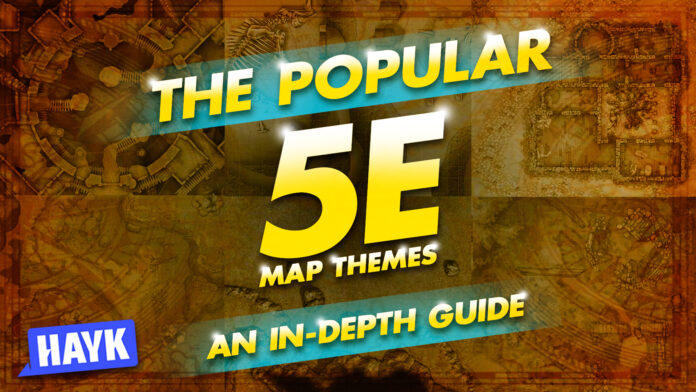
Maps are essential parts of a D&D campaign. Every map represents a location that can function as a battlefield or roleplay area. Practically, a map tells a story that involves all players and some NPCs.
In this article, you’ll read about the most popular D&D maps and locations. More importantly, you will also learn some tips on how to survive these maps.
Why You Should Trust Us
Here at Hayksaakian.com, we care about all aspects of D&D – especially map creation and usage. Aside from suggesting the best map themes, we’re ready to go the extra mile by sharing useful strategies for players. We’re also happy to share some D&D products that can help DMs and players alike.
Popular 5E Maps Explored
Classic Plains or Prairie
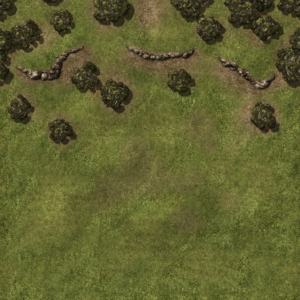
Advantages:
- A large open field for exploration and combat positioning
- Low chances of ambush
- Easy navigation
Disadvantages:
- Foraging will yield lower results
- The party’s campfire can be easily spotted
- No extra cover from wandering beasts
The prairie is an excellent transition map that can serve as the bridge between two or more important locations. More often than not, DMs reduce prairie exploration into a few narrative sentences to save time in every session. While this is a valid storytelling strategy, it can diminish the importance of session maps and transitional locations. Plus, players might miss out on some juicy XP!
A prairie map contains huge acres of grasslands, wildflowers, and uneven sections of land. Such areas are possibly owned by influential lords and even supernatural creatures. Since there are no forests or deeply hidden locations in a prairie, camping is rather easy. There are no natural threats except for wandering monsters, patrolling warbands, or sudden deadly storms.
Navigating a prairie is also easy because there’s almost no terrain challenge at all. The DM can add extra locations like abandoned farms or mysterious monoliths, but that’s about it. Also, foraging is less effective in a prairie because of poor shrub growth and lack of game.
Woodlands
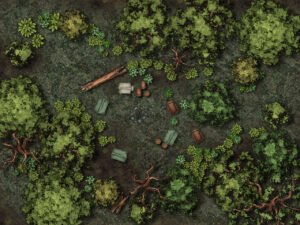
Advantages:
- Lots of foraging materials and game to be hunted
- Excellent cover from pursuing enemies or hunters
- Best place to grind XP
Disadvantages:
- Lots of ambush zones – especially from ferocious beasts
- Deadly forest traps and environmental hazard
- It’s easy to get lost
Woodlands or forests are the best zones for adventurers to test their mettle. Regular forests are filled with mysteries, danger, and untamed creatures driven by hunger and desperation. Ancient jungles, on the other hand, contain the secrets of old civilizations and the cunning plots of hidden cultists.
If you’re a DM, you must use a woodland map theme at least once in your campaign. This map evokes the sense of adventure among players. Combat-focused players will be challenged by the environmental shift, and simulationists will do everything to explore the forest.
The canopy of the forest can also provide cover for players who are running away from active pursuers. If the players made a couple of more-than-decent rolls, they can even build traps to subdue or eliminate their pursuers.
Navigation can also be problematic in woodlands. A party passing through a dense forest must have an expert navigator that can constantly roll 15 or higher in Survival checks. Or at the very least, that party must have a lenient DM.
Marsh or Boglands
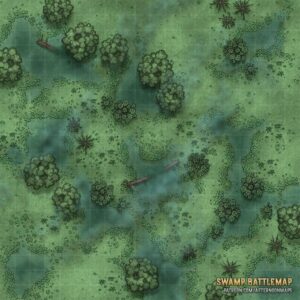
Advantages:
- A great challenge for daring players
- Moderate to high XP guaranteed
- A chance to find sunken or deeply hidden treasure
Disadvantages:
- Nearly impossible to take a rest
- Lots of deadly creatures and monsters
- The environment is against players
- It’s easy to get lost due to thick mists
One of the most dangerous maps that you’d encounter is a large marsh or boglands. In this map, every section is filled with foul and disgusting lumps of mud, dirt, and excrement. Rotted corpses or bones are also common in boglands, as well as deadly mutated creatures.
While a marsh-themed map can be disadvantageous, it offers a trove of levelling opportunities for daring players. In a marsh, players can hunt dangerous beasts like flesh ogres, shambling mounds, elite undead, bogland mud creatures, giant cockroaches, and even corrupted ents. Such monsters will yield high XP and monster reagents. It’s dirty work but definitely profitable!
Another problem with the marsh map is the constant appearance of mists. The mists can provide cover for dangerous beasts, elevating the danger scale further. Plus, mists can worsen the navigational ordeal in the boglands. Players may need to make a couple of CON and Survival checks just to leave the place successfully.
Machinarium
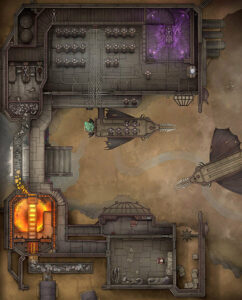
Advantages:
- An exciting place for discoveries
- Cool steampunk environment
- Flexible – the map can be full of laboratories or dungeons
- Interesting NPCs and quest hooks
Disadvantages:
- Strong enemies with lots of immunities and resistances
- Traps are everywhere
- Magic might suffer from weird effects
A machinarium is a strange map that players will rarely encounter. This map has a strong steampunk vibe combined with arcane weirdness and tons of other interesting stuff. If you’re a DM with limited time, you can set up a machinarium as a semi-sentient dungeon or laboratory. You don’t even have to look far because the monsters needed for a machinarium can be easily looked up online.
One of the advantages of a machinarium is the promise of discovery. In this map, players can explore every nook and cranny to find treasures and materials. Artificers and alchemists will enjoy the treasure-hunting spree because of the cool things that they can find.
Here are some common treasures that can be found within a machinarium:
- High-value gems and minerals
- Energy canisters or troves
- Exotic weaponry
- Strange currency with collectible value
- Technical guides and blueprints
- Strange potions and concoctions
- Imprisoned familiars
- Inventions
- Trinkets with limited uses
- Powerful components
- Quest pieces, turnkeys, and heirlooms
Even though a machinarium guarantees rewards for explorers and dungeon-delvers, it’s not a casual walk in the park. Machinariums contain mechanical or arcane-powered guardians like golems, weird constructs, and unleashed elementals. These guardians cannot be defeated easily because of their abilities, resistances, and immunities. And of course, a decent DM won’t just let a machinarium be looted without challenge!
Spellcasters might also have a challenging yet exciting time inside a machinarium. Commonly, strange laboratories and steampunk dungeons can mess up magic in different ways. A cantrip may not work in a specific room or a high-level spell can backfire and activate something sinister. Traps can also make things worse, so players are advised to really work together.
Gloomy Horror Town
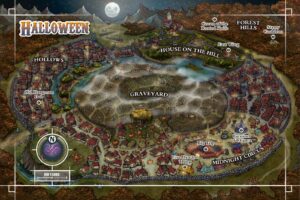
Advantages:
- Great for horror fans
- A place of deep intrigue and mysteries
- A chance to find powerful treasures or artifact
Disadvantages:
- Psychological horror can mess with characters
- Sinister plots can jeopardize the party
- Multiple factions might get upset by players’ actions
- Deadly curses are everywhere
How can we get out? This is a question commonly asked by players who are trapped inside a horror village or town. Such a question can’t be answered easily because DMs have to weave a tale of survival, challenge, and scaling danger.
A gloomy horror town is filled with mysteries and deep intrigue. Players might find civilians with hidden agenda and officials who are planning something big and evil. Faction politics is also prevalent in an unsupervised horror town – let alone in a horror campaign.
Aside from mysteries, players can find powerful treasures in a gloomy horror town if they know where to look. These treasures can be used to fight the evil forces of the land, but they might also have some curses that can affect players. Curses can be tricky to avoid because of their hidden nature, and they can only be dispelled through the means of powerful rituals.
Evil is also the strongest presence that anyone can encounter in a horror town. Such evil presence is usually linked to powerful creatures like undead, specters, vampires, and even deranged cultists. Therefore, it’s important for players to destroy evil forces before leaving the horror town. Well, the players’ heroism doesn’t apply if they are also evil to begin with!
In terms of XP, horror towns are acceptable grinding spots. DMs can plug in specific monster zones or quest areas. The small quests from a horror town can also be linked to the greater campaign plot, fueling the motives and desires of antagonists.
Cave Complex
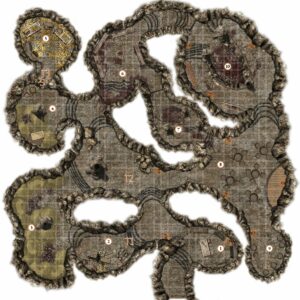
Advantages:
- Many caverns and rooms to explore
- A great place to hide stuff in
- Gives a deep sense of control for DMs
Disadvantages:
- Cave dungeons can be tedious to explore
- Natural traps are everywhere
- Bottlenecks are common
A cave complex is an underground map filled with danger and rewards. Usually, players can find earthen rooms and caverns in a sprawling cave complex. These rooms contain monsters, treasure chests, shelves, and even deadly traps. In many ways, a cave complex map is a great option for grinding XP and rewards.
Running a cave complex encounter is also relatively easier because of the controlled environment. DMs can simply generate a detailed dungeon map online and plug it in for the entire session. It’s possible to design a cave complex in 30 minutes or less.
However, underground dungeons are somehow tedious for many players. Exploring one or two dungeon areas is enough, but going past three can somehow feel very dragging. If you’re a DM running a cave complex, you must keep things exciting by adding plot hooks or mini-quests. Perhaps the players can find a trapped NPC in one of the caverns or a malevolent entity wreaks havoc on the adventurers. The rewards should also match the potential of danger and risks.
Players should expect natural traps in a cave complex. Some of the common traps are boulder-rollers, spike pits, arrow shooters, area-based toxins, and flammable substances. Kobolds can also be problematic in underground caverns because of their affinity for traps and expert tunnelling.
Best Tools and Accessories To Help You Make Awesome Map Themes
If you’re looking for some tools and accessories for map-making, you’ve come to the right place. In this article section, we’re ready to share some of the best map-making products that can be ordered online.
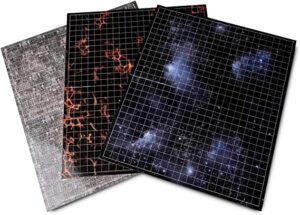
Pros:
- Different foldable terrains
- Dry-erasable mats
- Impressive storage case
Cons:
- The mats aren’t too durable
- Only one folding direction
Are you tired of making D&D maps from scratch over and over again? In that case, you should try the pre-made battle mats from the Hexers RPG Game Mat bundle. The bundle contains 8 different terrains representing multiple battlefield locations. Each battle mat measures 26 x 22 squares – big enough for a memorable combat encounter.
All of the Hexer battle mats have erasable surfaces. You can write on the surfaces using a marker and erase the details after the session. Pen and pencils are not advisable because they can damage the game mat surfaces.
Durability is a common problem among the Hexer battle mats. It’s easy to rip a battle mat if you take it out from the box the wrong way. Folding the mat in the wrong direction can also induce faster wear and tear.
Dungeon Craft Board Game With 1000 Map Pieces
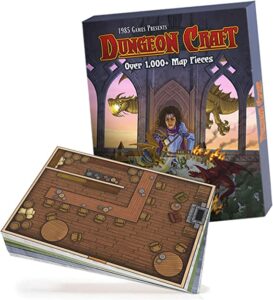
Pros:
- Custom and interactive battle maps
- 1000 reversible and adjustable terrain pieces
- Water-resistant and dry-erase maps
Cons:
- Some irregular portions and designs
- Too many trees in one box
A modular dungeon map is always handy for every D&D game session. In this type of map, you can exercise nearly limitless creativity and decision-making. But instead of making everything from scratch, you should get a complete map-creation box such as Dungeon Craft Board Game.
The Dungeon Craft Board Game contains multiple battle maps combined in loose-leaf book. These maps have dry-erase capability, allowing anyone to leave marks or special reminders. The maps are also water-resistant. Aside from the map, the box contains up to 1000 terrain pieces that can be adjusted accordingly.
There are different themes that you can make with the Dungeon Craft bundle. Some common themes are dungeons, cities, and forested areas. Additionally, you can modify some of the maps to fit your desired idea.
One problem with the Dungeon Craft board game is design inconsistency. You will notice some poorly trimmed portions and faded designs. Also, a Dungeon Craft box contains many tree cut-outs than you’d ever care to use. You probably need to repurpose the trees into other cut-out materials like terrain embellishments or scattered ore veins.
The Fundamental Campaign Planner Book

Pros:
- Thick and compact diary/planner
- High-quality and elegant-looking pages
- Dry erase sheets
Cons:
- Loose pages
- Inconsistent cover design
A great campaign starts with a simple collection of notes. Instead of jotting down your ideas in a flimsy notebook, you can just start with the Fundamental Campaign Planner from The Rook & The Raven store.
The Fundamental Campaign Planner has the hallmarks of a special vintage organizer. Every page is intricate, containing visual details, lines, and fillable overlays. The planner’s flexible disc binding also allows quick page-turning. You can even remove some of the pages and rearrange them according to your priorities. The cover also looks nice despite the inconsistent design patterns and faded letters.
The Fundamental Campaign Planner suffers from the common problem among basic organizers: loose pages. These pages can be easily torn apart by deliberate and sudden movements. To keep your Fundamental Campaign Planner intact, you must turn the pages with total care and precision. After every session, you can put the planner on a separate carrying case.
Art 101 Doodle and Color 142-pc Art Set
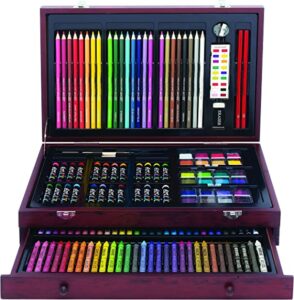
Pros:
- A massive set of colored pencils and art materials
- Portable storage box
- Budget-friendly
Cons:
- Some pieces are easy to lose
- Inconsistent color quality
What if you intend to create a D&D map from scratch? The task can be gruelling, but it can be shortened by using the right materials. The Art 101 Doodle and Color Art Set will make your sketching task easier. This set contains 142 materials divided among coloring pencils, oil pastels, crayons, and watercolor tubes.
Designing multiple terrains has never been easier with the Art 101 Art Set. You can simply choose from regular colors or premium colors. Obviously, the premium colors have the best quality but they are always complemented by the simple colors. The pastels are also nice even if they are fewer than the pencils and crayons. While the pencils can highlight the sketches, the pastels can bring life to your entire map. The watercolors, on the other hand, are great for bringing out your inner artistic style.
The Art 101 Art Set is not a perfect product. You’d realize that some of the coloring pencils and oil pastels are easy to lose. Plus, these coloring materials have inconsistent quality. Some colors work effectively on flat surfaces while others do not. You probably need to test out a couple of colors before working on a final design.
7-in-1 Multitool Pen for Professional Sketching

Pros:
- Impressive 7-in-1 pen tool
- Durable and easy-to-use
- Great for map-makers and campaign creators
Cons:
- Minor misalignment issues with the tools
- Fast wear and tear (i.e. paint chipping)
Map sketching is always more fun if the designer can access multiple aspects of the project at the same time. If you want to achieve this, you should forget about using a bulky set of tools and unrelated materials. Instead, you can just rely on a Multitool Pen from the UMEINAC TECH store.
The 7-in-1 Multitool pen consists of almost everything you need for professional map sketching. The tool consists of different components like stylus, bubble leveller, inch-ruler, cm-ruler, ballpoint pen, Philips screwdriver, and a flathead screwdriver. With this multitool pen, you can create different maps and design custom terrain pieces easily.
Some of the problems of the Multitool pen are misalignment and fast wear and tear. Within just a few months, you will notice that the Multitool components are misaligned. You can always adjust the components but it will take a portion of your working time. Paint chipping is also a noticeable problem affecting the ruler component. To slow down the Multitool pen’s wear and tear, you should put it in a separate case after working.
How To Survive In A Strange Unknown Map?
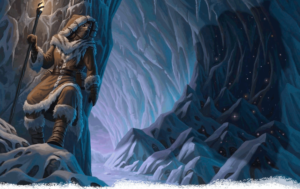
In the countless worlds of D&D, many characters’ lives were already claimed by strange and unchecked locations. The common culprits are dangerous beasts, traps, and environmental danger. But the biggest culprit is none other than unpreparedness!
Here are some important tips to help you survive on a strange unknown map:
Use Your Ability Checks Properly
Ability checks will increase your character’s chance of survival in a strange map or location. Perception checks, for example, will help you notice danger or traps in the immediate vicinity. A survival check is also necessary if you want to forage for supplies or navigate a revealed choke point. Other checks are highly situational and limited by the DM’s permission or decision.
Every character in a party can do ability checks with varying proficiencies and capabilities. Some characters are excellent navigators while others can spot deadly traps within seconds. So, as much as possible, you must work closely with your party members. Make suggestions and provide assistance to your friends who have low ability modifiers.
Another piece of advice that you should remember is do not assume. DMs can change bits of information quickly as part of creating a deep engrossing challenge. If you can fully utilize all ability checks, you can somehow stay a few steps ahead of the curve and gain significant advantage.
Locate and Secure Vantage Points
Every D&D map has a great chance to lead to an encounter or two. Before bad things happen, players must do everything to tilt the odds in their favor. As a survival-focused player, one of the things that you can do is to secure vantage points.
A vantage point is a specific area that gives you a marginal shred of advantage (not advantage in terms of ruling, but it’s also possible). This vantage point can be an overlooking cliff section, allowing you to spot arriving enemies. Vantage points, after all, are essential for setting up ambushes or surgical strikes.
Strategic exits are also considered vantage points. Whenever an encounter turns south, the players must have a convenient exit point like a prepared portal or a secret hedgeway that leads to a safe and secluded location.
Always remember that any map has at least one vantage point. Don’t hesitate to ask your DM about it.
Prepare the Right Tools and Spells
Sometimes, ability checks can only go so far. Eventually, you will need some tools and spells just to survive an exotic map.
Take a look at some of these tools and their purposes:
- Rope – For scaling high or unreachable locations safely
- Wooden cart – For moving supplies from one spot to another
- Any light source – Important for providing illumination
- Ball bearings – Useful for setting improvised traps
- Spikes and metal fillings – For improvised traps as well
- Canoes – Great for navigating through narrow rivers
- Writing tools – For leaving clues or messages
- Caltrops – Great for delaying pursuers
Just like tools, spells are also important even though they are limited. Spellcasters should plan ahead and prepare the right spells based on the situation. If there’s an incoming battle, offensive spells must be prioritized. Plus, spellcasters can never go wrong with terraforming and utility spells. And lastly, at least one slot should be reserved for an escape spell.
Mind Your Party’s Formations
If tools and spells are immediate ways of boosting survival chances, formations are less subtle alternatives. Many D&D groups forget about the importance of formations because they’re focused on simply winning the encounter. In effect, this error compounds with unpreparedness and leads to a potential encounter loss or TPK.
It’s actually easy to utilize formations before the start of any battle. In a normal formation, beefy characters should take the frontline and turn the enemies away from squishy characters. Rogues can also utilize flanking positions to deliver a couple of sneak attacks against unsuspecting enemies.
The composition of characters can determine the formations that a D&D party can make. Mounted characters take spacious positions to make strong beeline charges while ranged characters can hurl death from above. Spellcasters can also set delayed arcane traps to kill or subdue potential enemies.
Brainstorming about formations is essential to a party’s survival. Discuss your character’s strengths and weaknesses, and don’t forget others’ inputs as well. Formations are battle plans, so always use them properly.
Utilize Summons and Familiars
Summonable creatures and familiars are not just beloved friends or distractions. They play important roles such as scouting, information delivery, and espionage. Keep in mind that only intelligent familiars can accomplish complicated tasks. Some DMs may ask for specific rolls to determine the success rate of a familiar.
If you’ve developed a deep emotional bond with your familiar, you should consider using summoned creatures. Even if these creatures perish from the dangers of the task, they can be resummoned again the next day (or the next instance).
Do not underestimate the capabilities of familiars and summoned creatures. They possibly hold the keys to the party’s survival.
FAQ
What is the best map theme for D&D 5E beginners?
Answer: The best map theme for beginners is the one with a balanced set of locations. An abandoned farm, for example, might have buildings that can be explored by players anytime. Such buildings might contain treasures or even clues leading to the campaign’s major plot line.
Do I need to use software to make D&D map themes?
Answer: If you want to save time, you can use advanced D&D map-making software. But keep in mind that you don’t have to pay for anything at all. You can even use pen and paper to create an exciting map. Free downloadable tools like GIMP also allows in-depth map creation even though the learning curve is a bit high.
What is the best map-making program for a beginner?
Answer: There is no such thing as the best map-making tool because every program has different strengths and weaknesses. However, one of the most popular map creation tools of all time is Inkarnate. With Inkarnate, you can create different kinds of maps and adventuring locations. You can also export your finished Inkarnate maps in resolution.
What terrain features are needed for a high-quality map theme?
Answer: It depends on the campaign that you intend to run. Still, you should always include an area with tolerable environmental conditions. This area might serve as the HQ of players or some kind of an extended outpost. Additionally, forests and mountainous areas are great for early or mid-level exploration.
What are some generic yet cool monsters to include in any D&D map?
Answer: Kobolds are some underused monsters that will make your map exciting. Since Kobolds are great with making traps, they can be challenging or deadly enough for the players. Owlbears are also excellent choices as long as their presence is truly menacing or disruptive. Magnify the threats of owlbears through the means of rumors, scattered clues, and even hints of destruction in the countryside.
What are the best treasures to include in D&D maps?
Answer: There’s no definite answer when it comes to treasures, but DMs should always include potions, reagents, and a few semi-powerful artifacts. It’s important to keep a balance between proper rewards and overpowered choices.
What are some common landmarks or points of interest for any D&D map?
Answer: Some of the common landmarks are ruins, abandoned temples, fey rings, barns, abandoned creepy houses, dungeon rooms, laboratory sections, kitchens, and even wide living halls. But always remember that plain landmarks will just become empty areas without proper quests or introductory stories. Weave stories on every landmark and observe as your players decide to explore every section with pure interest.
Conclusion
Choosing a map for your D&D 5E campaign shouldn’t be too difficult. Just focus on connecting the maps to the overall style of your campaign. In this way, the maps won’t feel forced or unnatural. You also don’t need to include so many maps. Simply choose one per session and let theater-of-the-mind take over. This will allow players to use their imagination most of the time.
Don’t forget to check out some of our chosen D&D map-making accessories:
- Hexers RPG Game Mat Bundle
- 7-in-1 Multitool Pen for Professional Sketching
- Art 101 Doodle and Color 142-pc Art Set
- The Fundamental Campaign Planner Book
- Dungeon Craft Board Game With 1000 Map Pieces
What is your favorite D&D map theme? Share it in the comments’ section below!


